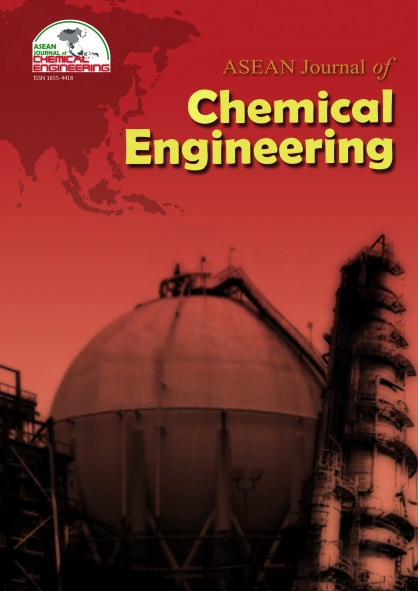Optimization for Production Tert-Butyl Oleyl Glycoside Nonioic Surfactant Using Response Surface Methodology
Abstract
The development of surfactant production process strongly influenced by the potential use of raw materials and products that are environmentally friendly. For raw materials such as surfactants are carbohydrate-based material utilization example, glucose, which is reacted with tert-butanol, to form tert-butyl glycoside (TBG), then TBG can be esterified with oleic acid forming surfactant tert-butyl oleyl glycoside (TBOG). This study aims to obtain the optimum conditions TBOG production process of esterification reactions TBG and oleic acid catalyst the para toluene sulfonic acid using response surface method to reach optimum yield TBOG. The independent variable used is the mole ratio of TBG with oleic acid, percent of the catalyst and a temperature. Optimization results obtained optimum conditions of mole ratios of 1: 4.096; 2.33 percent of the catalyst and the temperature of 96.04 °C with a TBOG yield of 92.46%, with a TBOG content of 91.72 %. Based on the HLB value of the surfactant TBOG is 3.87, then these surfactants can be used as an emulsifier of water-in-oil.References
2. Schick, M.J. (1987). Nonionic Surfactants, Physical Chemistry, Dekker, New York.
3. Sela, Y., Garti, N., and Magdassi, S. (1993). Surface activity and emulsification properties of new polyethyleneglycol based nonionic surfactants, J. Dispersion. Sci. Technol. 14, 237-247
4. Zaijun, L., Rui, Y., Zhongyun, L., and Fushan, Y. (2005). Synthesis of a novel dialkylaryl disulfonate gemini surfactant. J. Surfact. Deterg., 8,337-340
5. El-Sukkary, M.M., Syed, N.A., Aiad, L., and El-Azab, W.I.M. (2008). Synthesis and characterization of some alkyl polyglycosides surfactants. J. Surfact. Deterg., 11, 129-137.
6. Hill, K., and Rhode, O. (1999) Sugar-based surfactants for consumer products and technical applications. Fett/Lipid., 101, 25-33.
7. Rosen, M.J. (2004). Surfactants and interfacial phenomena, 3 Ed, John Wiley & Sons, Inc, New Jersey.
8. Hait, S.K., and Moulik, S.P.J. (2001). Determination of critical micelle concentration (CMC) ofnonionic surfactants by donor-acceptor interaction with lodine and correlation of CMC with hydrophile-lipophile balance and other parameters of the surfactants. J. Surfact. Deterg. 4, 303-309
9. Sembiring, H.Br., (2007), Pembuatan surfaktan tert-butil galaktosida melalui reasksi galaktosa dengan tert-butanol, J. Penelitian Mipa, 1, 34-37.
10. Khuri, A.L., and Mukhopadhyay, S. (2010). Response surface methodology, Wiley Interdiscip. Rev. Comput. Stat. 2, 128-149
11. Zhang, H., Liu, M., Han, S., and Wei, Y. (2013). Optimizing the Extraction of Catechin from Peanut Red Skin Using Response Surface Methodology and its Antioxidant Activity, IERI Procedia, 5, 312-320.
12. Yemis, O., and Mazza, G. (2012) Optimization of furfural and 5-hydroxymethyl furfural production from wheat straw by a microwave-assisted process, Bioresour. Technol. 109, 215-223
13. Vuong, Q.V., Golding, J.B., Stathopoulos, C.E., Nguyen, M.H., and Roach, P.D. (2011). Optimizing conditions for the extraction of catechins from green tea using hot water, J. Sep. Sci. 34, 3099-3106.
14. Raymond, H.M., and C.M. Douglas, M.A. (2016). Response surface methodology: process and product optimization using designed experiments, 4 Ed, John Wiley & Sons, Canada.
15. Bezerra, M.A., Santelli, R.E., Oliveira, E.P., Villar, L.S., and Escaleira, L.A. (2008). Response surface methodology (RSM) as a tool for optimization in analytical chemistry.Talanta, 76, 5
16. Raji, N.A., and Oluwole, O.O. (2014). Phase field simulation for recrystallization kinetics of cold-drawn 0.12 wt % C steel in full annealing, Int. J. Sci. Eng. Res. 5, 335-349
17. Adisalamun, D., Mangunwidjaya, A., Suryani, Sunarti, T.C., and Arkeman, Y. (2012). Process optimization for production of alkyl polyglycosides nonionic surfactant using response surface methodology, J. Teknologi Industri Pertanian, 22, 51-57.
18. Voung, Q.V., Nguyen, V.T., Thanh, D.T., Bhuyan, D.J., Goldsmith, C.D., Sadeqzadeh, E., Scarlett, C.J., and Bowyer, M.C. (2015). Optimization of ultrasound-assisted extraction conditions for euphol from the medicinal plant, euphorbia tirucalli, using response surface methodology, Industr. Crops Prod. 63,197-202.
Copyright holder for articles is ASEAN Journal of Chemical Engineering. Articles published in ASEAN J. Chem. Eng. are distributed under a Creative Commons Attribution-NonCommercial 4.0 International (CC BY-NC 4.0) license.
Authors agree to transfer all copyright rights in and to the above work to the ASEAN Journal of Chemical Engineering Editorial Board so that the Editorial Board shall have the right to publish the work for non-profit use in any media or form. In return, authors retain: (1) all proprietary rights other than copyright; (2) re-use of all or part of the above paper in their other work; (3) right to reproduce or authorize others to reproduce the above paper for authors’ personal use or for company use if the source and the journal copyright notice is indicated, and if the reproduction is not made for the purpose of sale.



